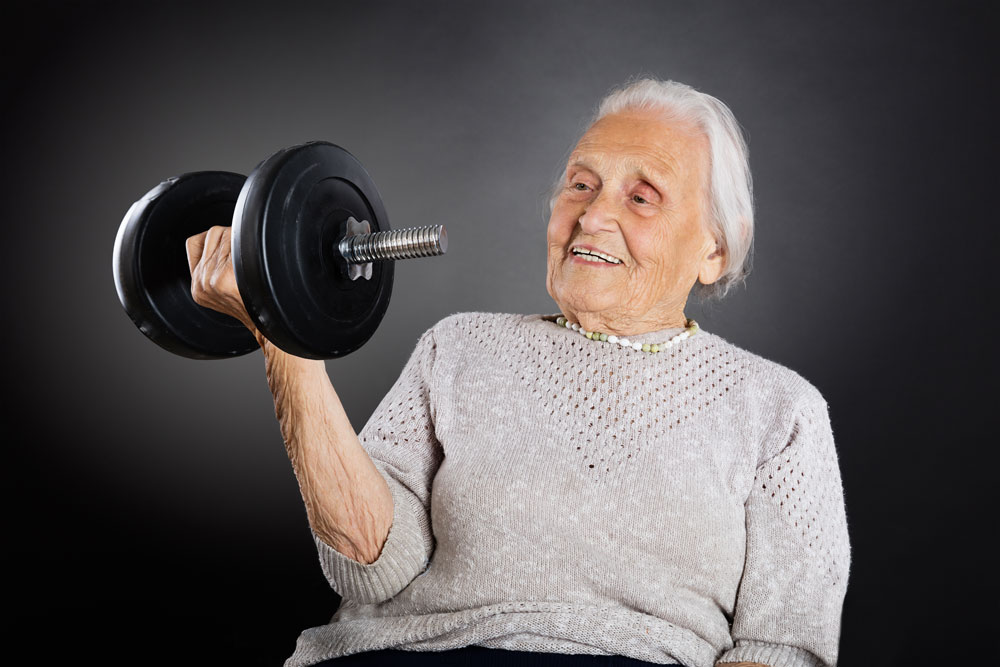Physical Exercise
This AI translated article is based on Swedish conditions. Hopefully, it can inspire those interested from other countries.
There are benefits to strength training and balance exercises for older people. It helps to keep the body active and reduces the risk of fall injuries. There are good balance exercises that are also suitable for the elderly and the physiotherapist at the residence can develop exercises that are suitable for each resident. With consideration, it is possible to create opportunities and inspire appropriate physical activity for everyone living in the elderly home. Music can often stimulate increased movement. By including balance exercises in the daily routine, it is possible to increase independence and reduce the risk of falls, which can contribute to an active and healthy old age.
 Foto: Mostphotos
Foto: MostphotosMany experience joy and happiness despite illness, sorrow, and aging. Health and illness have a dimension beyond sick and healthy. There is much that each individual can do themselves to keep both memory and body going. Physical exercise has been shown to protect against many changes in the body that contribute to aging. In fact, those who start exercising at an old age can become "younger" in a physical sense.
The fact is, it is never too late to start exercising. A seventy-five-year-old who starts exercising can reach the same fitness level as a normally trained twenty-five-year-old. It is possible to resume functions that have been lost. There are many elderly people who participate in the Vasaloppet, cycle around Vättern, and even complete the Ironman. The training should be adapted to the elderly so that they don't get injured.
It is entirely possible to increase strength and muscle mass with properly designed training. With exercise, one can maintain or increase balance and the ability to manage the activities that make the resident independent in everyday life. The risk of falls, fractures, infections, and other things decreases with exercise.
There are nursing homes where a group of residents go for a long walk every day. A thirty-minute walk does wonders for a person's energy. By keeping the muscles going, balance improves and the risk of falls decreases. Memory improves while it is a pleasant daily routine where those participating have a good time together. Daylight contributes to the formation of necessary vitamin D, but also to counteract depression and depression.
A few years ago, during a study visit, we went through the premises. The accommodation was well planned and vibrant. When we came to the gym, a man in his nineties was sitting there doing leg presses. He told us that he had started training when he moved in. When I saw him sit in the leg press, I was amazed. He had almost all the weights on and managed to press out his legs. Training should always be individually adapted, training of the balance sense reduces the risk of falls.
Exercise and Aging
Large parts of the population are less physically active than what is required to maintain good health. It is a major challenge. The need for measures that can identify and reduce the risk of age-related diseases such as dementia is great. Physical activity can serve as a preventive measure against dementia. In addition, it can slow down the development of dementia in people who have already developed dementia.
Studies in Sweden show that physical exercise in the form of high-intensity training two to three times a week for people who have dementia slows down the development of dementia. In addition, it contributes to the elderly maintaining balance better. The best effect was achieved by those with vascular dementia during the study, which only lasted for four months.
FaR
Physical activity on prescription FaR is a concept that has existed for many years. FYSS (Physical activity in disease prevention and treatment for everyone) is a book that was published in 2004. In it, there are concrete training tips for different disease states and can be used very well in elderly care. Many elderly people stop exercising when they get sick when they should instead exercise more. Exercise counteracts harmful stress hormones and leads to increased circulation in the heart and blood vessels. As it decreases blood fats, lowers blood pressure, and improves bowel function, the risk of various injuries decreases.
Collaborations have been started to improve the health of the population and reduce drug use. Instead of prescribing drugs as before, the resident can get FaR, which means written advice on a prescription form. The prescription is preceded by motivational talks. Conversations can help the resident change their habits and behavior.
It is never too late to start moving. Many nursing homes today have access to gyms and it happens that elderly people who have not been so inclined to exercise earlier in life start exercising when they move in.
All forms of movement affect the body positively. Sleep, memory, learning, and concentration ability are positively affected. By standing on one leg when you brush your teeth or dancing while washing dishes, you can train your balance.
For frail elderly, the training should be adapted. Occupational therapists or physiotherapists should adapt the training to the person's limitations. A good working method stimulates the residents to activate themselves according to their conditions. There are studies showing that it is possible to achieve measurable improvement in terms of muscle strength and functional ability despite old age and chronic diseases among the residents.
At the same time, those who start exercising at an old age can increase both strength and muscle mass. This, in turn, reduces the risk of falls, infections, and other illnesses and can add more healthy years to life.
Osteoporosis
Osteoporosis is a public health problem. The healthcare system often misses the diagnosis and many do not get treatment in time. Drug treatment and individualized training contribute to healing. Outdoor activities and a varied diet can help prevent the onset of osteoporosis. Untreated osteoporosis carries an increased risk of fractures.
Osteoporosis is a condition with decreased bone mass and changes in the structure of bone tissue. This means that the skeleton becomes weaker and the risk of fractures increases. Especially the most ill among the elderly is a risk group that should be investigated. Osteoporosis itself does not hurt but the consequences can be painful. Microfractures in the back and other fractures can be very painful.
A woman who was affected got small fractures on the vertebrae with an almost unbearable pain as a result. Pain medications provided almost no relief and her life became very limited. It was even so that she considered applying for a nursing home, as she could not take care of her home and herself. With treatment for osteoporosis, she could eventually return to a more normal life.
According to SBU (The Swedish Agency for Health Technology Assessment and Assessment of Social Services), osteoporosis should be treated actively. For those who have already had an osteoporosis fracture, the risk of getting more is more than 50 percent. Drug treatment can significantly reduce the risk of new fractures. Far too few receive treatment for the disease.
Many with osteoporosis suffer from kidney failure or COPD. They may have drugs that further increase the risk of osteoporosis. Confirmed osteoporosis should always be treated. The recommendations also apply to men.
Supplement to Drug Treatment
• Drug review where drugs that increase the risk of falls are discontinued or reduced in dose, and
• Investigation of other risks for fall injuries such as sudden changes in blood pressure, dizziness, anemia, irregular heart rhythm, visual or sensory impairment.
• Fall preventive measures in the home, such as removing small rugs.
• Aids such as walkers and hip protection pants.
• Evaluation of drugs with an increased risk of osteoporosis, such as long-term treatment with corticosteroids, antiepileptic drugs, thyroxine.
• Individually adapted physical activity to increase balance, coordination, and muscle strength in order to prevent falls and fractures.
• Quit smoking and be careful with alcohol intake.
• Sun exposure - regular outdoor visits.
• Eat a diet rich in calcium.
Examples of balance training that may be suitable for the elderly
Balance is essential for maintaining independence and reducing the risk of falls in older adults. Including balance exercises in the daily routine can be a simple and effective strategy for promoting well-being and safety.
Standing on one leg Hold onto a chair or wall for extra stability if needed. Lift one leg and balance on the other for about 10-15 seconds. Switch legs and repeat.
Heel walk Walk on your toes for a few steps and then walk on your heels for a few steps. Repeat this exercise forward and backward to improve balance and coordination.
Side shuffles Stand with your feet together. Take a step to the side and bend gently at the knee as you move to the side. Return to the starting position and repeat on the other side.
Toe and Heel Drag Stand with your feet together. Slowly lift your toes upward and then lower them back to the ground. Repeat with the heel by lifting the heel up and lowering it back.
Balance board Use a balance board if possible. Stand on the board and try to keep your balance while the board moves gently.
Chair Gymnastics Sit on a chair with your feet flat on the floor. Lift one foot off the floor and hold it in the air for a few seconds before putting it down again. Repeat with the other foot.
Yoga and Tai Chi Exercises like yoga and tai chi focus on balance, flexibility, and relaxation and can be particularly beneficial for older adults.
Balance exercises should be adapted to the resident's ability and needs. It is important to perform these exercises regularly to improve and maintain your balance. Consult the physiotherapist at the nursing home for advice on which exercises are best suited.
Reflection - Physical Training
Care Staff:
• What can you do to get your residents to exercise?
• Are there conditions for the individual to exercise, e.g. access to a gym at the nursing home?
• Are there people with you who exercise regularly?
• Do you have any who have osteoporosis?
• What can you do to stimulate your residents to activate themselves?
Manager, Nurse, Occupational Therapist, and Physiotherapist:
• What do you do to create conditions for and stimulate training?
• Are training groups organized?
• Is training included in the activity schedule?
• Do you evaluate your work with physical activity regularly?
• Do all residents participate in some form of physical activity?
• Do you work in any particular way with people who have osteoporosis?
• Does it work well with diet, outdoor activities, and physical activity?
Residents and Relatives:
• Are there conditions at the residence for training?
• Can you contribute to your relative being stimulated to maintain mobility and energy?
• How does training and walks work?
Erland Olsson
Specialist nurse
Sofrosyne - Better care every day

Aktuellt i media
- 2025-11-06 04:00 13 Hygien
- 2025-11-03 04:00 10 Aktivitet o funktionsbevarande arbetssätt
- 2025-10-21 15:54 04 Bemötande
-
2025-10-19 04:00
13 Hygien
It is important that all cleaning is carried out as often and with the quality required.
info Foto: Mostphotos
Foto: Mostphotos - 2025-10-16 04:00 06 Dokumentation
- 2025-10-13 04:00 09 Mat och måltid




